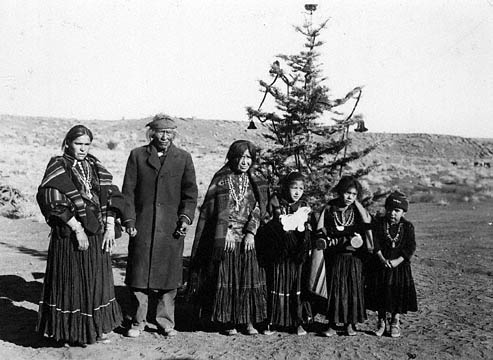The Navajos call themselves Dine’ — “the People” — which implies that other humans are “not-people” or are enemy people (anaii dine’e). Dine’ has a broad meaning; it means not just earth people, but holy people — diyin dine’e — with whom the Navajos are closely associated, thus giving them a sense of their divinity, or contentedness to the gods.
Peshlakai Etsetti Navajo Family with Christmas Tree – 1935 Christmas at Wupatki
Photo courtesy NAU Cline Library Special Collections
In this, of course, they are not unique. All ethnic groups imagine themselves as chosen. James Axtell has written that the Indians of Canada and New England believed that they were superior to the French and English.
They thought their way of life the best, and when runaway Indian schoolboys returned to their tenacious cultures, they quickly relapsed into the old way. The prideful eastern Natives, whose conceit the Christian divines condemned as sinful, simply did not believe in the superiority of “civilization.”
The same may be said for the Navajo. The proscriptions laid on the true people by the Holy Beings did not apply to the non-Navajo. For instance, at one time (and still perhaps today), Navajos relied on Anglos to bury corpses as a way to avoid contamination by the dead.
Flora Bailey was asked to examine a corral of dead, blackened sheep that had been struck by lightning. If Navajos observed the lightning-struck sheep, they would become ill; if Bailey looked at them, she would not get sick because she was a white person, a non-Navajo.
In the early part of this century, Little Gambler asked William T. Williams to bury his brother, who was killed by lightning. Williams also shot a horse over his grave as Little Gambler requested. Little Gambler, however, would not attend the burial, and Williams did not tell him that before he got the corpse in the ground a coyote had fed on his brother’s body.
The proscriptions of the Holy Beings did not apply to the whites, so that Williams would not contaminate himself as the Navajo ran the risk of doing.
Navajo religion — its beauties, its curing, and indeed its taboos — extended its advantages and restrictions only to the Navajos.
Source: William H. Lyon, “Americans and Other Aliens in the Navajo Historical Imagination in the Nineteenth Century,” American Indian Quarterly24.1 (2000): 143, Questia, 20 Oct. 2007
Navajo People Website Links:
Navajo Culture – Navajo History – Navajo Art – Navajo Clothing Navajo Pictures – Navajo Rugs – Navajo Language – Navajo Jewelry – Navajo Code Talker – Navajo Pottery – Navajo Legends – Hogan’s – Sand Painting – Navajo Food – Navajo News – Navajo Nation

